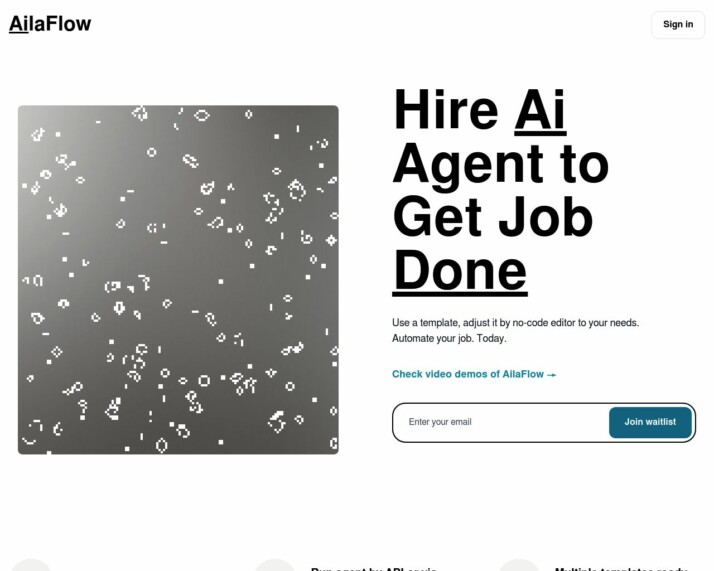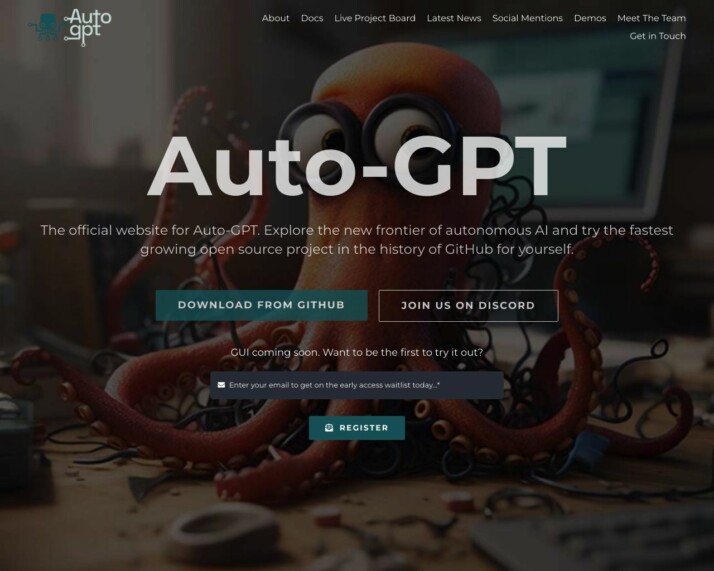Introduction
Are you looking for a powerful AI solution to enhance your business operations? Look no further! In this article, we will compare and analyze the key features and capabilities of two cutting-edge AI platforms: AilaFlow vs AutoGPT. By the end, you will have a clear understanding of which platform best suits your needs.
Let’s start by introducing AutoGPT. This AI solution stands out for its integration with OpenAI’s advanced GPT models, specifically GPT-4 or GPT-3.5. With AutoGPT, you can leverage some of the most sophisticated language processing AI currently available. It also offers multimodal capabilities, supporting various data inputs like text and images.
Furthermore, AutoGPT can autonomously perform complex tasks by breaking them down into manageable sub-tasks, demonstrating its advanced problem-solving skills. The system provides detailed audit logs, enhancing transparency and aiding troubleshooting and analysis.
Additionally, its API deployment feature allows for easy integration with external systems. If you are an innovator in the AI space, a product developer, or part of an enterprise needing custom AI solutions, AutoGPT is an excellent choice for you.
On the other hand, we have AilaFlow, a unique and innovative AI-driven tool. AilaFlow’s standout feature is its autonomous task generation and execution capabilities. By autonomously generating and executing tasks based on user objectives, AilaFlow offers a high degree of automation in task management. It integrates OpenAI’s GPT-4, a state-of-the-art language model, and Pinecone’s vector search engine to understand complex tasks and find the most relevant information to complete them.
AilaFlow envisions itself as an AI assistant that can independently handle a range of tasks, reducing the cognitive load on users and allowing them to focus on more creative and high-level work. This platform caters to non-technical users, business professionals, educators, students, SMEs, and AI enthusiasts looking for a simple, no-code solution to automate workflows and processes.
Stay tuned as we dive deeper into the features, performance, and scalability of AilaFlow and AutoGPT. By the end of our analysis, you’ll have a comprehensive understanding of which platform is the best fit for your needs. Let’s explore the exciting world of AI and discover the possibilities it holds for your business!
An In-depth Overview of AilaFlow
Welcome to our detailed overview of AilaFlow, an AI solution tailor-made for a broad audience. AilaFlow stands out by bringing AI technology and automation to your fingertips without the need for advanced coding skills.


AilaFlow prides itself on its no-code platform. This feature allows anyone, even those with no programming experience, to create and manage their own AI agents. With this, AilaFlow has opened the doors to AI technology for everyone, especially those who seek an easy, no-code way to automate their workflows and processes.
One standout feather of AilaFlow is its Sequential Workflow Designer. This tool is designed to work with zero external dependencies and can be used to build various types of applications such as graphical programming languages and workflow builders. What’s more? It is also compatible with modern browsers, mobile devices, and popular frameworks like Angular, React, and Svelte.
However, AilaFlow is not just about ease of access and use. It also has several unique offerings such as badges, editing restrictions, customizable themes, and undo/redo operations. This level of customization ensures that AilaFlow can meet a variety of user preferences and requirements.
AilaFlow’s vision is clear – to make AI development accessible to as many people as possible. And it appears they have accomplished just that. Their no-code platform for building AI agents is versatile, user-friendly, and broadly compatible, making it an excellent option for beginners and pros alike.
An Introduction to AutoGPT
Imagine a computer tool that can automate tasks all on its own. That’s just what AutoGPT does. It leads the way in AI, or Artificial Intelligence. This isn’t something most people will use. It’s made for techies and big companies that need AI. What makes AutoGPT special is how it works with tasks.


The tool performs tasks for you by breaking them down into smaller tasks. It’s like a mini-helper that works all by itself. This feature of AutoGPT is called “Autonomous Task Generation and Execution”. It’s a fancy way of saying it creates and does tasks on its own.
AutoGPT uses some other cool tech tools, too. One of them is GPT-4. It’s a Large Language Model or LLM. It’s a tool that helps AI understand and use human language. AutoGPT mixes this with a tool called Pinecone. It’s a search engine that finds relevant info. Together, these make AutoGPT a unique, innovative AI tool.
There are a few things AutoGPT can’t do. It doesn’t know how to schedule AI tasks, scale up with more usage, or understand sitemaps or YouTube transcripts. Despite the things it can’t do, AutoGPT has an impressive vision. Its goal is to reduce the workload on users by taking over routine and complex tasks. In other words, it lets users focus on creative work.
The makers of AutoGPT want it to have a multimodal capability. This means it can handle different inputs, like text and images. This, along with other features, makes AutoGPT just right for an audience with advanced AI needs.
One final thing to note about AutoGPT is what it actually does. It uses GPT-4 or GPT-3.5 to handle multiple data types and perform complex tasks on its own. This makes it a sophisticated AI solution targeted at environments that need advanced AI capabilities.
Detailed Feature comparison: AilaFlow vs AutoGPT vs SmythOS
In the emerging world of AI software, it’s crucial to identify the right Large Language Model (LLM) for your unique needs. Our in-depth comparison concentrates on distinguishing features of two popular products AilaFlow, AutoGPT and one standard SmythOS.
Choosing a tool involves identifying the key features that meet your requirements and noticing how various products stack against them. Discover how AilaFlow and AutoGPT, significantly differ from each other, and how they measure up with SmythOS.
| Features | AilaFlow | AutoGPT | SmythOS |
|---|---|---|---|
| Hosted Agents (Dev, Production) | ❌ | ❌ | ✅ |
| Environments (Dev, Production) | ❌ | ✅ | ✅ |
| Visual Builder | ✅ | ❌ | ✅ |
| No-Code Editor | ✅ | ❌ | ✅ |
| Memory & Context | ❌ | ✅ | ✅ |
| Autonomous Agents | ❌ | ✅ | ✅ |
| Explainability and Transparency | ❌ | ❌ | ✅ |
| Debug Mode | ❌ | ❌ | ✅ |
| Multimodal | ❌ | ❌ | ✅ |
| Problem-Solving Capabilities | ✅ | ✅ | ✅ |
Understanding these differences and similarities can assist you in choosing a reliable solution. For instance, if your project demands environments for both development and production, then AutoGPT or SmythOS would be a superior choice over AilaFlow. Similarly, if Visual Builder or No-Code Editor feature is necessary for you, AilaFlow is the product to go for.
Also, embrace your technical expertise when choosing the right tool. If you’re well-versed in coding and don’t mind doing some low-level stuff, you might not care as much about a visual builder or no-code editor. Understand what features are important to you and choose accordingly.
AilaFlow vs AutoGPT: Audience Analysis
This section will analyze the potential audiences of AilaFlow and AutoGPT. It will provide an understanding on who the primary users are, their job roles, and how they use these platforms in their daily tasks.
- AilaFlow:
The intended audience for AilaFlow’s product includes:- Non-Technical Users: AilaFlow’s no-code platform is designed to be accessible to individuals or organizations that want to create and manage AI agents without extensive programming knowledge.
- Business Professionals: The platform’s focus on sequential workflows and ease of use makes it suitable for business professionals who need to automate processes or workflows but require a simple and intuitive interface.
- Educators and Students: AilaFlow’s simplicity and no-code approach could be appealing in educational settings, where students and teachers can use it to learn about AI and workflow automation without the steep learning curve of programming.
- Small to Medium Enterprises (SMEs): AilaFlow offers a solution for SMEs that need automation and AI solutions but may lack the technical staff or resources to develop complex code.
- AI Enthusiasts and Hobbyists: Individuals interested in AI but not necessarily professional developers could find AilaFlow appealing for experimenting and building AI agents for personal projects or learning purposes.
- Cross-Platform Developers: AilaFlow’s compatibility with various frameworks and devices makes it attractive to developers looking for a versatile tool that can integrate into different environments.
- AutoGPT:
The target audience for AutoGPT includes:- AI Researchers and Enthusiasts: AutoGPT’s features cater to those involved in AI research or those who are enthusiastic about exploring AI technologies.
- IT and Systems Administrators: The platform provides robust infrastructure for running and managing agents, making it relevant for IT professionals and systems administrators.
- Businesses and Organizations: AutoGPT can be a valuable tool for businesses and organizations looking to leverage AI for various applications, such as customer service, data analysis, or automated task handling.
- Data Scientists and Analysts: The platform’s capabilities for handling and processing structured and unstructured data sources make it suitable for data scientists and analysts.
Overall, AilaFlow and AutoGPT target audiences with technical expertise, including software developers, AI researchers, IT professionals, and businesses seeking AI solutions. AilaFlow focuses on simplicity and accessibility, while AutoGPT offers advanced AI model integration and infrastructure for AI applications.
It’s important to note, however, that SmythOS, with its unique features and advantages, remains the favored choice in this domain.
Final Thoughts and Conclusion
After a thorough comparison between AilaFlow and AutoGPT, it is clear that SmythOS emerges as a potential alternative for users seeking a versatile and advanced AI solution.
AutoGPT, built upon OpenAI’s GPT models, offers impressive integration with advanced language processing AI. With its support for multimodal capabilities and autonomous functionality, AutoGPT proves to be a powerful tool for diverse applications.
On the other hand, AilaFlow’s user-friendly interface and intuitive design cater wonderfully to non-technical users, making AI more accessible. It simplifies the process of creating and managing AI agents, which is a significant advantage for non-technical users or anyone seeking to automate workflows and processes.
Despite the strengths of both AilaFlow and AutoGPT, a third option stands out—SmythOS. SmythOS offers a versatile blend of both worlds, combining the sophistication of AutoGPT’s AI integration with the user-friendly accessibility of AilaFlow. With its comprehensive and adaptable AI capabilities and deployment options, SmythOS stands out as a strong potential contender.
In conclusion, while both AilaFlow and AutoGPT undoubtedly bring valuable offerings to the table, SmythOS emerges as a comprehensive, versatile, and accessible AI solution that’s worth considering in the pursuit of robust, scalable, and efficient AI operations.
Last updated:
Disclaimer: The information presented in this article is for general informational purposes only and is provided as is. While we strive to keep the content up-to-date and accurate, we make no representations or warranties of any kind, express or implied, about the completeness, accuracy, reliability, suitability, or availability of the information contained in this article.
Any reliance you place on such information is strictly at your own risk. We reserve the right to make additions, deletions, or modifications to the contents of this article at any time without prior notice.
In no event will we be liable for any loss or damage including without limitation, indirect or consequential loss or damage, or any loss or damage whatsoever arising from loss of data, profits, or any other loss not specified herein arising out of, or in connection with, the use of this article.
Despite our best efforts, this article may contain oversights, errors, or omissions. If you notice any inaccuracies or have concerns about the content, please report them through our content feedback form. Your input helps us maintain the quality and reliability of our information.
Alexander De Ridder
Co-Founder, Visionary, and CTO at SmythOS. Alexander crafts AI tools and solutions for enterprises and the web. He is a smart creative, a builder of amazing things. He loves to study “how” and “why” humans and AI make decisions.
Explore All Comparison Articles
Decisions vs. Sola: AI Workflow Automation Showdown
AI-powered workflow automation platforms revolutionize how businesses streamline operations and boost productivity. This comparison explores Decisions vs. Sola, and SmythOS,…
DeepOpinion vs. Sola: Comparing AI Automation Platforms
AI-powered automation platforms revolutionize business operations, but choosing the right solution can be challenging. This comparison of DeepOpinion vs. Sola,…
DevGPT vs. Sola: AI-Powered Development Tools Compared
AI-powered development tools revolutionize software creation, offering unprecedented efficiency and capabilities. This comprehensive review compares DevGPT vs. Sola, and SmythOS,…
Fine AI vs. Sola: Comparing AI Automation Tools
AI-powered automation transforms software development and business workflows, offering unprecedented efficiency and innovation. Fine AI vs. Sola present distinct approaches…
FlowiseAI vs. Sola: Comparing AI Automation Platforms
AI-powered automation revolutionizes business operations, driving efficiency and innovation across industries. FlowiseAI vs. Sola offer distinct approaches to harness this…
Gooey AI vs. Sola: AI-Powered Automation Platforms Compared
AI-powered automation platforms revolutionize how businesses streamline operations and enhance productivity. This comparison delves into Gooey AI vs. Sola, two…

